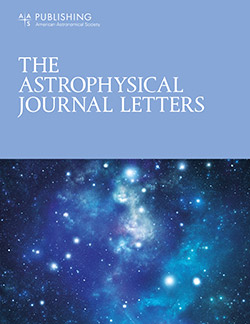向外迁移雪线形成的星子中的冰升华
IF 8.8
1区 物理与天体物理
Q1 ASTRONOMY & ASTROPHYSICS
引用次数: 0
摘要
陨石的同位素研究表明,星子形成了两个不同的种群:非碳质(NC)和碳质(CC)储层。最近的一个模型通过考虑雪线在原行星盘迁移过程中星子的形成来解释这种二分法,表明NC星子是在向外迁移期间形成的,CC星子是在向内迁移期间形成的。这个模型被认为与陨石观测相矛盾,因为在雪线形成的星子预计富含h2o,因此比NC铁陨石推断的环境更具氧化性。然而,如果被吸积的冰升华成蒸汽而没有转变成液态,那么星子可能会失去大部分的水而没有被氧化,因为在与冰直接升华相关的温度下,蒸汽和固体之间的反应是可以忽略不计的缓慢。在这里,我们研究了星子内部的蒸汽输送,并提出,如果:(1)星子是在向外雪线迁移期间形成的(形成后它们位于雪线内部,表面可渗透水蒸气),(2)这些星子是由尘埃砾石通过“流不稳定性”形成的,而不是由亚微米尘埃颗粒直接形成的,那么孔隙压力就足够低,可以直接实现冰升华。(3)这些巨石的大小在几厘米到10米之间。根据这些结果,NC/CC星子形成的雪线模型可能与铁陨石氧化态的观测结果相一致。本文章由计算机程序翻译,如有差异,请以英文原文为准。
Ice Sublimation in Planetesimals Formed at the Outward Migrating Snowline
Abstract Isotopic studies of meteorites suggest that planetesimals were formed as two distinct populations: noncarbonaceous (NC) and carbonaceous (CC) reservoirs. A recent model explains this dichotomy by considering planetesimal formation at the snowline during its migration in the protoplanetary disk, suggesting that NC planetesimals were formed during the outward migration and CC planetesimals were formed during the inward migration. This model has been suggested to contradict meteorite observations because planetesimals formed at the snowline are expected to be rich in H 2 O and, therefore, develop more oxidizing environments than those inferred from NC iron meteorites. However, if the accreted ice sublimates into vapor without transitioning into a liquid state, the planetesimals may lose most water without being oxidized because reactions between vapor and solids are negligibly slow at temperatures relevant to direct ice sublimation. Here, we investigate the transport of vapor inside a planetesimal and suggest that the pore pressure would have been sufficiently low for direct ice sublimation if (1) the planetesimals were formed during the outward snowline migration (such that they lay inside the snowline after formation and had surfaces permeable to water vapor), (2) these planetesimals were formed by dust-aggregate boulders through “streaming instabilities” instead of being formed directly by submicrometer dust grains, and (3) the boulders were between a few centimeters to ~10 m in size. With these results, the snowline model for NC/CC planetesimal formation may be reconciled with the observations of iron meteorite oxidation states.
求助全文
通过发布文献求助,成功后即可免费获取论文全文。
去求助
来源期刊

Astrophysical Journal Letters
ASTRONOMY & ASTROPHYSICS-
CiteScore
14.10
自引率
6.30%
发文量
513
审稿时长
2-3 weeks
期刊介绍:
The Astrophysical Journal Letters (ApJL) is widely regarded as the foremost journal for swiftly disseminating groundbreaking astronomical research. It focuses on concise reports that highlight pivotal advancements in the field of astrophysics. By prioritizing timeliness and the generation of immediate interest among researchers, ApJL showcases articles featuring novel discoveries and critical findings that have a profound effect on the scientific community. Moreover, ApJL ensures that published articles are comprehensive in their scope, presenting context that can be readily comprehensible to scientists who may not possess expertise in the specific disciplines covered.
 求助内容:
求助内容: 应助结果提醒方式:
应助结果提醒方式:


